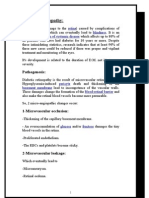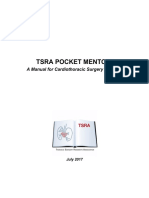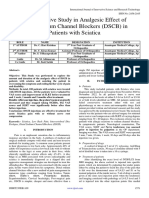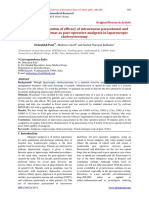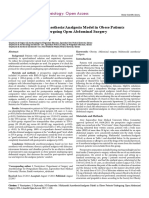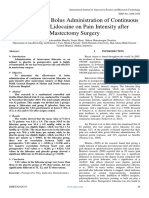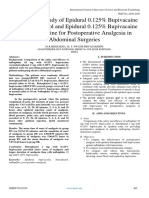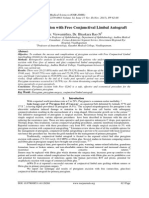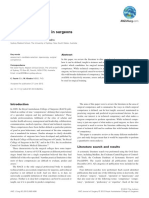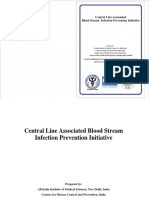Professional Documents
Culture Documents
Comparison of Postoperative Analgesic Effects of Epidural Ropivacaine With Butorphanol Versus Epidural Ropivacaine With Morphine in Patients Undergoing Below Umblical Surgeries
Copyright
Available Formats
Share this document
Did you find this document useful?
Is this content inappropriate?
Report this DocumentCopyright:
Available Formats
Comparison of Postoperative Analgesic Effects of Epidural Ropivacaine With Butorphanol Versus Epidural Ropivacaine With Morphine in Patients Undergoing Below Umblical Surgeries
Copyright:
Available Formats
Volume 8, Issue 1, January – 2023 International Journal of Innovative Science and Research Technology
ISSN No:-2456-2165
Comparison of Postoperative Analgesic Effects of
Epidural Ropivacaine with Butorphanol Versus
Epidural Ropivacaine with Morphine in Patients
Undergoing below Umblical Surgeries
Dr. P. Kavitha Sree1, Dr. B. Harikrishna2
Post Graduate1, Assistant Professor2
Department of Anaesthesiology,
Kurnool Medical College, Kurnool,
Andhra Pradesh
Abstract:- I. INTRODUCTION
Background: Comparison of the safety and efficacy of
butorphanol(2mg ) with 0.2% ropivacaine versus The International Association for the Study of Pain(
morphine (3mg ) with 0.2%ropivacaine by epidural IASP) defines pain as an unwelcome emotional and
route for providing postoperative analgesia in patients sensitive experience associated with factual or implicit
undergoing below umbilical surgeries. tissue damage or described in terms of similar damage.
Uncontrolled pain in the postoperative period may
Methodology: The patients were allotted randomly into 2 produce a range of detrimental acute and chronic effects.
groups. One group (Group RB) received 0.2% of Adequate pain control is essential and has been
Ropivacaine and 2mg of Butorphanol epidurally and recognized as a prime concern for anaesthesiologists.
another group (Group RM) received 0.2% Epidural analgesia using local anaesthetics alone or
Ropivacaineand 3mg of Morphine epidurally. combined with opioids provides adequate pain relief in the
postoperative period. Combination of opioids to local
In the postoperative period, when the patients
anaesthetic solutions placed in the epidural space results
complained of pain, the intensity of pain was assessed
in improved analgesia.
using the VAS scale The pain intensity was assessed by
VAS score at 0, 15, 30, 60 minutes, 2, 4, 6, 8, 10 and 12 The present study’s primary goal is to assess and
hours after epidural injection, onset of analgesia, compare the safety and efficacy of epidurally administered
duration of analgesia, Systolic blood pressure, diastolic butorphanol and morphine as adjuvants with bupivacaine for
blood pressure, pulse rate, and respiratory rate were postoperative analgesia in below umbilical surgeries.
recorded at 0, 15, 30, 60 minutes, 2, 4, 6, 8,10 and 12
hours after epidural injection. SpO2 monitored II. MATERIALS AND METHODS
continuously.
The study was conducted in 100 patients of both male
Results: The average onset time of analgesia of group RB and female sex in the age group of 18-60 years meeting
was 12.34 ±1.18 minutes and the meantime of onset of ASA class I and II criteria and are undergoing abdominal
analgesia in group RM was 15.56 ±1.14 minutes. The surgeries electively in Government General Hospital,
mean duration of analgesia was 251±42.68 minutes in Kurnool.
group RB and the mean duration of analgesia was 355.4
± 68.1 minutes in group RM. Inclusion criteria
Patients belonging to the age range of 18 to 60 years
Conclusion: Butorphanol (2mg) with 0.2% ropivacaine Both Sex
provided faster onset of analgesia and shorter duration Patients of ASA grade I and II
of analgesia than with morphine(3mg) with 0.2% Patients undergoing elective infraumbilical surgeries.
ropivacaine.
Exclusion criteria
Keywords:- Epidural, ropivacaine, butorphanol, morphine,
Patient refusal
post operative analgesia.
Patients of ASA grade III, IV and V
Infection at the site of injection
Patients with coagulation abnormalities
Patients with hypersensitivity to local anaesthetics
IJISRT23JAN1309 www.ijisrt.com 2501
Volume 8, Issue 1, January – 2023 International Journal of Innovative Science and Research Technology
ISSN No:-2456-2165
The patients were randomly divided into two group as of the intensity of postoperative pain and were instructed to
mark on the scale at the point which he she felt was
GROUP RB: received 0.2% Ropivacaine plus representative of their position of discomfort.
Butorphanol (2mg),total volume 10ml. In the postoperative period, when the patients complained
of pain, the intensity of pain was assessed using the VAS
GROUP RM (control group): received
scale. When the VAS score was >5, the study drug was
0.2%Ropivacaine plus Morphine (3mg), total volume 10ml.
given through the epidural catheter.
The patients were explained about the epidural method P-Value <0.001 was taken as statistically highly
with the catheter in situ. They were also educated about the significant.
operation of direct visual analog scale( VAS) for assessment
III. OBSERVATIONS AND RESULTS
A. Onset Of Analgesia:
The mean time of onset of analgesia in group RB was 12.34 ±1.18 minutes, and the meantime of onset of analgesia in group
RM was 15.56 ±0.1.14 minutes. The onset of analgesia was faster in group RB compared to group RM, and it was statistically
significant (p<0.05).
Fig. 1: ONSET OF ANALGESIA
B. Duration Of Analgesia:
The mean duration of analgesia was 251.6±42.68minutes in group RB, and the mean duration of analgesia was
355.4±68.1mintues in group RM. The duration of analgesia was longer in group RM compared to group RB, and it was
statistically significant (p<0.05).
Mean duration of group Mean SD p-value
analgesia (Minutes) <.0.01
RB 251 42.68
RM 355.4 68.1
Table 1: Duration Of Analgesia
Fig. 2: DURATION OF ANALGESIA
IJISRT23JAN1309 www.ijisrt.com 2502
Volume 8, Issue 1, January – 2023 International Journal of Innovative Science and Research Technology
ISSN No:-2456-2165
Fig. 3: DBP At Various Time Intervals:
Fig. 4: Complications
C. Vas Score: IV. AIMS AND OBJECTIVES
The mean VAS score forgroup RB and group RM is
significant at 10 min,15 min and 4 hours with a p A. Aims
value<0.05. Comparison of the safety and efficacy of
butorphanol(2mg) with 0.2% ropivacaine vs.
D. Onset Of Analgesia: morphine(3mg) with 0.2% ropivacaine by epidural route for
In the present study, the mean time of onset of analgesia providing postoperative analgesia in patients undergoing
in the group RB was 12.34 ± 1,18 minutes, and in the group, below umbilical surgeries.
RM was 15.56 ± 1.14 minutes. The difference in the mean
time of onset of analgesia between the two groups was B. Objectives
statistically significant, with group RB having the faster To compare the effectiveness of postoperative analgesia
onset of analgesia than group RM (12.34 minutes vs. 15.56 with epidural butorphanol with ropivacaine against
minutes). morphine with ropivacaine.
To compare associated hemodynamic changes.
E. Duration Of Analgesia: To compare side effects like hypotension, bradycardia,
In the present study, the mean duration of analgesia in nausea, vomiting, pruritis, sedation, shivering, motor
the group RB was 251.6 ± 42.68min, and in the group, BN, block and respiratory depression
the mean duration of analgesia was 355.4 ± 68.1min. The Group RB received Butorphanol(2mg) + 0.2%
difference in the mean duration of analgesia between the ropivacaine (total volume of 10 ml).
two groups was statistically significant (p<0.05), with group Group RM received morphine (3mg) + 0.2%
RM having a longer duration of analgesia than the group RB ropivacaine (total volume of 10 ml).
(355.4 ± 68.1min vs. 251.6 ± 42.68min).
IJISRT23JAN1309 www.ijisrt.com 2503
Volume 8, Issue 1, January – 2023 International Journal of Innovative Science and Research Technology
ISSN No:-2456-2165
The following parameters were observed.
Stastisticalanalysis :
The pain intensity was assessed by VAS score at 0, 15, In this study, 100 patients were made into 2 groups,
30, 60 minutes, 2, 4, 6, 8,10 and 12 hours after epidural each comprising of 50 patients.
injection if patient complains of pain even after epidural Continuous variables were represented as mean and
injection intensity is assessed with VASscore and If it was standard deviation where data follows a normal
>5, a non-opioid analgesic was given. distribution, otherwise as median with range.
Categorical variables were represented as frequencies
and percentages.
The statistical significance of the difference in the
outcome variables between the groups was assessed by
the Chi-Square test, Fisher’s exact test, and t-test.
Onset of analgesia: P-Value <0.05 was taken as significant statistically.
The time interval from the administration of the study
drug till the VAS score came down to <5. VAS Score:
In group RB, the mean VAS scores at 0 min, 15 min,
Duration of analgesia:
30 min, 60 min, 2 hrs, and 4 hrs were 8.26±1.64, 6.6±1.22,
The time interval between onset of analgesia, till patient 0.96±0.7, 0.58±0.67, 1.02±0.65, and 1.26±0.69. In group
complained of pain (VAS score >5) when rescue RM, the mean VAS scores at 0 min, 15 min, 30 min, 60 min,
medication was given. 2 hrs, and 4 hrs were 7.42±1.41, 6±1.41, 0.78±0.70,
Systolic blood pressure, diastolic blood pressure, pulse 0.36±0.52, 0.78±0.64, and 0.8±0.75. VAS scores for group
rate, and respiratory rate were recorded at 0, 15, 30, 60 RB and RM is significant at 15 mintues and 4 hours with p
minutes, 2, 4, 6, 8,10 and 12 hours after epidural value <0.05.
injection. SpO2 monitored continuously.
Side effects like pruritis, nausea, vomiting, hypotension,
bradycardia, sedation, motor block, shivering, and
respiratory depression was recorded in both groups.
Mean time of Group Mean(min) SD p-value
onset of analgesia RB 12.34 1.18
RM 15.56 1.14 <0.01
Table 2: VAS SCORE
Fig. 5: VAS Score
IJISRT23JAN1309 www.ijisrt.com 2504
Volume 8, Issue 1, January – 2023 International Journal of Innovative Science and Research Technology
ISSN No:-2456-2165
Fig. 6: SBP at Various Time Intervals:
V. CONCLUSION [4.] Kumar M, Suwalka U, Kumar H, Ankita. Comparison
of epidural butorphanol versus nalbuphine as
From our study, we conclude thatButorphanol adjuvants with bupivacaine for abdominal
(0.04mg/kg) with 0.2% ropivacaine provided faster onset of hysterectomy: A prospective randomized, double-
analgesia than with morphine(0.06mg/kg) with 0.2% blind controlled clinical study. Global
ropivacaine. [5.] Journal for research analysis. 2018;7(5). DOI:
10.36106/gjra.
Morphine(0.06mg/kg) with 0.2% ropivacaine provided
a longer duration of analgesia than with
butorphanol(0.04mg/kg) with 0.2% ropivacaine.
From the present study, we concluded that butorphanol
as additive to epidural ropivacaine provides a rapid,
excellent analgesia with shorter duration when compared to
epidural ropivacaine with morphine. nausea, vomiting,
pruritus and hypotension are common with morphine as
additive to epidural ropivacaine where as sedation was seen
more commonly when butorphanol is used as additive.in
view of safety profile,epidural ropivacaine in the treatment
of postoperative pain for below umbilical surgeries
.however, continuous monitoring is required.
REFERENCES
[1.] Babu S, Gupta BK, Gautam GK. A comparative study
for post operative analgesia in the emergency
laparotomies: Thoracic epidural ropivacaine with
nalbuphine and ropivacaine with butorphanol. Anesth
Essays Res. 2017;11:155-9.
[2.] Sharma S, Naik S, Jamale PB, Dhulkhed VK,
Prasoon A. A comparison of epidural butorphanol
2mg and fentanyl 75 mcg for postoperative analgesia
using combined spinal epidural anaesthesia
technique: A randomized doubleblind clinical study.
IJMHR. 2018;4(4):97-101.
[3.] Chakravarthy NN, Sagar A, Venkateshwarlu G. A
comparative study of epidural 0.5% bupivacaine with
nalbuphine and .5% bupivacaine with fentanyl in
lower abdominal and lower limb surgeries. IAIM.
2018;5(2):124-134.
IJISRT23JAN1309 www.ijisrt.com 2505
You might also like
- 4 - Surgical Approaches To The Elbow 2012 Orthopaedics and TraumaDocument6 pages4 - Surgical Approaches To The Elbow 2012 Orthopaedics and TraumaProfesseur Christian DumontierNo ratings yet
- Diabetic RetinopathyDocument18 pagesDiabetic Retinopathymohelshiekh100% (3)
- Dysrhythmia InterpretationDocument56 pagesDysrhythmia InterpretationgerajassoNo ratings yet
- Commando Surgery PDFDocument1 pageCommando Surgery PDFOlga0% (1)
- Assessment of Pain Management in Anaesthesia Practice among Nurse AnaesthetistsFrom EverandAssessment of Pain Management in Anaesthesia Practice among Nurse AnaesthetistsNo ratings yet
- AMO Phaco CatalogDocument7 pagesAMO Phaco Catalogaurora. guoNo ratings yet
- 7 2 Tsrapocketmentor PDFDocument34 pages7 2 Tsrapocketmentor PDFGaetano Di GiovanniNo ratings yet
- A Prospective Study in Analgesic Effect of Distal Sodium Channel Blockers (DSCB) in Patients With SciaticaDocument5 pagesA Prospective Study in Analgesic Effect of Distal Sodium Channel Blockers (DSCB) in Patients With SciaticaInternational Journal of Innovative Science and Research Technology100% (1)
- Malaysian Society of Anaesthesiologists College of Emergency Physicians, AMM College of Anaesthesiologists, AMM Academy of Medicine of MalaysiaDocument22 pagesMalaysian Society of Anaesthesiologists College of Emergency Physicians, AMM College of Anaesthesiologists, AMM Academy of Medicine of MalaysiabapaknyanadlirNo ratings yet
- Comparison of Analgesic Effects of Intravenous Nalbuphine and Pentazocine in Patients Posted For Short-Duration Surgeries A Prospective Randomized Double-Blinded StudyDocument4 pagesComparison of Analgesic Effects of Intravenous Nalbuphine and Pentazocine in Patients Posted For Short-Duration Surgeries A Prospective Randomized Double-Blinded StudyMuhammad AtifNo ratings yet
- 1 Article Ijpps ButorphanolDocument3 pages1 Article Ijpps ButorphanolMythology KingdomNo ratings yet
- GhimireDocument5 pagesGhimireJennifer GNo ratings yet
- The Effectiveness of Magnesium Sulphate Intravenous Bolus or Added As An Adjunct To Ropivacaine For Brachial Plexus Block in Upper Limb Orthopaedic SurgeriesDocument7 pagesThe Effectiveness of Magnesium Sulphate Intravenous Bolus or Added As An Adjunct To Ropivacaine For Brachial Plexus Block in Upper Limb Orthopaedic SurgeriesInternational Journal of Innovative Science and Research TechnologyNo ratings yet
- IJISRT23JUN363Document7 pagesIJISRT23JUN363International Journal of Innovative Science and Research TechnologyNo ratings yet
- DwefgnmjDocument8 pagesDwefgnmjfabian arassiNo ratings yet
- Gastrectomia 2018Document5 pagesGastrectomia 2018Zara DekeNo ratings yet
- 2264-Article Text-5024-4-10-20151024Document6 pages2264-Article Text-5024-4-10-20151024shivamNo ratings yet
- Synopsis SanskritiDocument22 pagesSynopsis Sanskritisanskriti_14No ratings yet
- A Comparative Study Between Epidural Nalbuphine and Fentanyl With Bupivacaine For Post Operative Analgesia in Lower Limb SurgeriesDocument15 pagesA Comparative Study Between Epidural Nalbuphine and Fentanyl With Bupivacaine For Post Operative Analgesia in Lower Limb SurgeriesIJAR JOURNALNo ratings yet
- Background: Result:: Published by DiscoversysDocument4 pagesBackground: Result:: Published by DiscoversysWilliam OmarNo ratings yet
- Effectiveness of Fascia Iliaca Compartment Block For Post Operative Analgesia After Surgery For Femur Bone FractureDocument12 pagesEffectiveness of Fascia Iliaca Compartment Block For Post Operative Analgesia After Surgery For Femur Bone FractureIJAR JOURNALNo ratings yet
- Rebound Pain and Postoperative Pain Profile Following Brachial Plexus Block Compared To General Anaesthesia-An Observational StudyDocument9 pagesRebound Pain and Postoperative Pain Profile Following Brachial Plexus Block Compared To General Anaesthesia-An Observational Studynvidia coreNo ratings yet
- Research2 1Document4 pagesResearch2 1mohamadrenegadeNo ratings yet
- Anasthesia in Obese PatientDocument4 pagesAnasthesia in Obese PatientWaNda GrNo ratings yet
- Apm009-02-07 2Document5 pagesApm009-02-07 2Kristine Lou Tan RualloNo ratings yet
- A Comparative Study Between Ketorolac and Ketoprofen in Postoperative Pain After Uvulop AlatopharyngoplastyDocument4 pagesA Comparative Study Between Ketorolac and Ketoprofen in Postoperative Pain After Uvulop AlatopharyngoplastyMIHAELANo ratings yet
- Journal Homepage: - : IntroductionDocument5 pagesJournal Homepage: - : IntroductionIJAR JOURNALNo ratings yet
- Journal Homepage: - : IntroductionDocument6 pagesJournal Homepage: - : IntroductionIJAR JOURNALNo ratings yet
- Anes 10 3 9Document7 pagesAnes 10 3 9ema moralesNo ratings yet
- EtamolDocument5 pagesEtamolthonyyanmuNo ratings yet
- Journal Homepage: - : IntroductionDocument4 pagesJournal Homepage: - : IntroductionIJAR JOURNALNo ratings yet
- PRM2017 1721460 PDFDocument6 pagesPRM2017 1721460 PDFmikoNo ratings yet
- Journal Homepage: - : Manuscript HistoryDocument7 pagesJournal Homepage: - : Manuscript HistoryIJAR JOURNALNo ratings yet
- My Published Paper 7.Document4 pagesMy Published Paper 7.mir sahirNo ratings yet
- 11 LdpopDocument5 pages11 LdpopBaru Chandrasekhar RaoNo ratings yet
- J000Document8 pagesJ000blabarry1109No ratings yet
- Wang 2000Document4 pagesWang 2000halimaNo ratings yet
- Intrathecal Fentanyl For Prevention of Shivering in Spinal Anesthesia in Cesarean SectionDocument5 pagesIntrathecal Fentanyl For Prevention of Shivering in Spinal Anesthesia in Cesarean SectionMuhammad Habibi NstNo ratings yet
- Effectiveness of Bolus Administration of Continuous Intravenous Lidocaine On Pain Intensity After Mastectomy SurgeryDocument6 pagesEffectiveness of Bolus Administration of Continuous Intravenous Lidocaine On Pain Intensity After Mastectomy SurgeryInternational Journal of Innovative Science and Research TechnologyNo ratings yet
- Medical Treatment Versus Radiofrequency Ablation For Patients With Trigeminal Neuralgia: A Prospective Clinical StudyDocument5 pagesMedical Treatment Versus Radiofrequency Ablation For Patients With Trigeminal Neuralgia: A Prospective Clinical StudyasclepiuspdfsNo ratings yet
- 3 PBDocument7 pages3 PBDinda ArmeliaNo ratings yet
- Comparison of Intravenous Magnesium Sulphate WithDocument8 pagesComparison of Intravenous Magnesium Sulphate Withshelly ranaNo ratings yet
- Ijca 7 2 313 318Document6 pagesIjca 7 2 313 318Bianca CaterinalisendraNo ratings yet
- Arp2017 5627062Document6 pagesArp2017 5627062sujidahNo ratings yet
- Comparative Study of Epidural 0.125% Bupivacaine With Butorphanol and Epidural 0.125% Bupivacaine With Nalbuphine For Postoperative Analgesia in Abdominal SurgeriesDocument7 pagesComparative Study of Epidural 0.125% Bupivacaine With Butorphanol and Epidural 0.125% Bupivacaine With Nalbuphine For Postoperative Analgesia in Abdominal SurgeriesInternational Journal of Innovative Science and Research TechnologyNo ratings yet
- JAnaesthClinPharmacol294459-335648 091924 PDFDocument6 pagesJAnaesthClinPharmacol294459-335648 091924 PDFaltaikhsannurNo ratings yet
- Journal AnestesiDocument5 pagesJournal AnestesitamiNo ratings yet
- 0102 8650 Acb 31 01 00067Document7 pages0102 8650 Acb 31 01 00067untung jakaNo ratings yet
- Randomized Controlled Trial of The Effect of Depth of Anaesthesia On Postoperative PainDocument6 pagesRandomized Controlled Trial of The Effect of Depth of Anaesthesia On Postoperative PainIntan PurnamasariNo ratings yet
- AN4 OA Sidharth-2Document6 pagesAN4 OA Sidharth-2Dede TarunaNo ratings yet
- DISSERTATION - Resident - 6.6Document18 pagesDISSERTATION - Resident - 6.6zzzzNo ratings yet
- Metamizole (Dipyrone) As An Additive To Lidocaine For Intravenous Regional AnesthesiaDocument5 pagesMetamizole (Dipyrone) As An Additive To Lidocaine For Intravenous Regional AnesthesiaelsahewuniNo ratings yet
- DR Surekha S Chavan, DR Stephan Jebaraj & DR Priya ChavreDocument10 pagesDR Surekha S Chavan, DR Stephan Jebaraj & DR Priya ChavreTJPRC PublicationsNo ratings yet
- Journal Homepage: - : IntroductionDocument8 pagesJournal Homepage: - : IntroductionIJAR JOURNALNo ratings yet
- Khan 2011Document2 pagesKhan 2011diego morenoNo ratings yet
- HindawiDocument6 pagesHindawiTaufiqo Nugraha SjachrilNo ratings yet
- Arp2018 1486261Document5 pagesArp2018 1486261Sheren ElinNo ratings yet
- Low Dose Levobupivacaıne 0.5% With Fentanyl in Spinal Anaesthesia For Transurethral Resection of Prostate SurgeryDocument6 pagesLow Dose Levobupivacaıne 0.5% With Fentanyl in Spinal Anaesthesia For Transurethral Resection of Prostate Surgeryblabarry1109No ratings yet
- Priyanka New PPT Final 2-1Document49 pagesPriyanka New PPT Final 2-1sourabh jakharNo ratings yet
- Effect of Dexamethasone As An Adjuvant To Bupivacaine in Ultrasound Guided Interscalene Brachial Plexus Block in Upper Arm SurgeriesDocument16 pagesEffect of Dexamethasone As An Adjuvant To Bupivacaine in Ultrasound Guided Interscalene Brachial Plexus Block in Upper Arm SurgeriesIJAR JOURNALNo ratings yet
- Analgesic Effects and Adverse Reactions of LidocaiDocument6 pagesAnalgesic Effects and Adverse Reactions of Lidocaibrendastevany23No ratings yet
- JMSCR Vol - 08 - Issue - 06 - Page 110-117 - JuneDocument8 pagesJMSCR Vol - 08 - Issue - 06 - Page 110-117 - JuneBianca CaterinalisendraNo ratings yet
- JMSCR Vol - 08 - Issue - 06 - Page 110-117 - JuneDocument8 pagesJMSCR Vol - 08 - Issue - 06 - Page 110-117 - JuneBianca CaterinalisendraNo ratings yet
- Comparative Study of Intrathecal Sufentanil Bupivacaine Versus Intrathecal Bupivacaine in Patients Undergoing Elective Cesarean SectionDocument5 pagesComparative Study of Intrathecal Sufentanil Bupivacaine Versus Intrathecal Bupivacaine in Patients Undergoing Elective Cesarean SectiontamiNo ratings yet
- Anjali Bhure, Neelakshi Kalita, Prasad Ingley, C.P. Gadkari: Research ArticleDocument5 pagesAnjali Bhure, Neelakshi Kalita, Prasad Ingley, C.P. Gadkari: Research ArticleTedja PrakosoNo ratings yet
- Artikel B.ind B.ing - Id.enDocument8 pagesArtikel B.ind B.ing - Id.enwikaNo ratings yet
- Influence of Principals’ Promotion of Professional Development of Teachers on Learners’ Academic Performance in Kenya Certificate of Secondary Education in Kisii County, KenyaDocument13 pagesInfluence of Principals’ Promotion of Professional Development of Teachers on Learners’ Academic Performance in Kenya Certificate of Secondary Education in Kisii County, KenyaInternational Journal of Innovative Science and Research Technology100% (1)
- Reading Intervention Through “Brigada Sa Pagbasa”: Viewpoint of Primary Grade TeachersDocument3 pagesReading Intervention Through “Brigada Sa Pagbasa”: Viewpoint of Primary Grade TeachersInternational Journal of Innovative Science and Research TechnologyNo ratings yet
- Application of Plant Growth Promoting Rhizobacteria on Vegetative Growth in Chili Plants (Capsicum frutescens L.)Document7 pagesApplication of Plant Growth Promoting Rhizobacteria on Vegetative Growth in Chili Plants (Capsicum frutescens L.)International Journal of Innovative Science and Research TechnologyNo ratings yet
- Exploring the Post-Annealing Influence on Stannous Oxide Thin Films via Chemical Bath Deposition Technique: Unveiling Structural, Optical, and Electrical DynamicsDocument7 pagesExploring the Post-Annealing Influence on Stannous Oxide Thin Films via Chemical Bath Deposition Technique: Unveiling Structural, Optical, and Electrical DynamicsInternational Journal of Innovative Science and Research TechnologyNo ratings yet
- Firm Size as a Mediator between Inventory Management Andperformance of Nigerian CompaniesDocument8 pagesFirm Size as a Mediator between Inventory Management Andperformance of Nigerian CompaniesInternational Journal of Innovative Science and Research TechnologyNo ratings yet
- Esophageal Melanoma - A Rare NeoplasmDocument3 pagesEsophageal Melanoma - A Rare NeoplasmInternational Journal of Innovative Science and Research TechnologyNo ratings yet
- PHREEQ C Modelling Tool Application to Determine the Effect of Anions on Speciation of Selected Metals in Water Systems within Kajiado North Constituency in KenyaDocument71 pagesPHREEQ C Modelling Tool Application to Determine the Effect of Anions on Speciation of Selected Metals in Water Systems within Kajiado North Constituency in KenyaInternational Journal of Innovative Science and Research TechnologyNo ratings yet
- A Study to Assess the Knowledge Regarding Teratogens Among the Husbands of Antenatal Mother Visiting Obstetrics and Gynecology OPD of Sharda Hospital, Greater Noida, UpDocument5 pagesA Study to Assess the Knowledge Regarding Teratogens Among the Husbands of Antenatal Mother Visiting Obstetrics and Gynecology OPD of Sharda Hospital, Greater Noida, UpInternational Journal of Innovative Science and Research TechnologyNo ratings yet
- Application of Game Theory in Solving Urban Water Challenges in Ibadan-North Local Government Area, Oyo State, NigeriaDocument9 pagesApplication of Game Theory in Solving Urban Water Challenges in Ibadan-North Local Government Area, Oyo State, NigeriaInternational Journal of Innovative Science and Research TechnologyNo ratings yet
- Mandibular Mass Revealing Vesicular Thyroid Carcinoma A Case ReportDocument5 pagesMandibular Mass Revealing Vesicular Thyroid Carcinoma A Case ReportInternational Journal of Innovative Science and Research TechnologyNo ratings yet
- Sustainable Energy Consumption Analysis through Data Driven InsightsDocument16 pagesSustainable Energy Consumption Analysis through Data Driven InsightsInternational Journal of Innovative Science and Research TechnologyNo ratings yet
- Detection of Phishing WebsitesDocument6 pagesDetection of Phishing WebsitesInternational Journal of Innovative Science and Research TechnologyNo ratings yet
- Vertical Farming System Based on IoTDocument6 pagesVertical Farming System Based on IoTInternational Journal of Innovative Science and Research TechnologyNo ratings yet
- The Impact of Music on Orchid plants Growth in Polyhouse EnvironmentsDocument5 pagesThe Impact of Music on Orchid plants Growth in Polyhouse EnvironmentsInternational Journal of Innovative Science and Research Technology100% (1)
- Osho Dynamic Meditation; Improved Stress Reduction in Farmer Determine by using Serum Cortisol and EEG (A Qualitative Study Review)Document8 pagesOsho Dynamic Meditation; Improved Stress Reduction in Farmer Determine by using Serum Cortisol and EEG (A Qualitative Study Review)International Journal of Innovative Science and Research TechnologyNo ratings yet
- Consistent Robust Analytical Approach for Outlier Detection in Multivariate Data using Isolation Forest and Local Outlier FactorDocument5 pagesConsistent Robust Analytical Approach for Outlier Detection in Multivariate Data using Isolation Forest and Local Outlier FactorInternational Journal of Innovative Science and Research TechnologyNo ratings yet
- Investigating Non-Newtonian Fluid Behavior in Hydrocyclones Via Computational Fluid DynamicsDocument18 pagesInvestigating Non-Newtonian Fluid Behavior in Hydrocyclones Via Computational Fluid DynamicsInternational Journal of Innovative Science and Research TechnologyNo ratings yet
- Review on Childhood Obesity: Discussing Effects of Gestational Age at Birth and Spotting Association of Postterm Birth with Childhood ObesityDocument10 pagesReview on Childhood Obesity: Discussing Effects of Gestational Age at Birth and Spotting Association of Postterm Birth with Childhood ObesityInternational Journal of Innovative Science and Research TechnologyNo ratings yet
- Realigning Curriculum to Simplify the Challenges of Multi-Graded Teaching in Government Schools of KarnatakaDocument5 pagesRealigning Curriculum to Simplify the Challenges of Multi-Graded Teaching in Government Schools of KarnatakaInternational Journal of Innovative Science and Research TechnologyNo ratings yet
- Detection and Counting of Fake Currency & Genuine Currency Using Image ProcessingDocument6 pagesDetection and Counting of Fake Currency & Genuine Currency Using Image ProcessingInternational Journal of Innovative Science and Research Technology100% (9)
- An Efficient Cloud-Powered Bidding MarketplaceDocument5 pagesAn Efficient Cloud-Powered Bidding MarketplaceInternational Journal of Innovative Science and Research TechnologyNo ratings yet
- Entrepreneurial Creative Thinking and Venture Performance: Reviewing the Influence of Psychomotor Education on the Profitability of Small and Medium Scale Firms in Port Harcourt MetropolisDocument10 pagesEntrepreneurial Creative Thinking and Venture Performance: Reviewing the Influence of Psychomotor Education on the Profitability of Small and Medium Scale Firms in Port Harcourt MetropolisInternational Journal of Innovative Science and Research TechnologyNo ratings yet
- Impact of Stress and Emotional Reactions due to the Covid-19 Pandemic in IndiaDocument6 pagesImpact of Stress and Emotional Reactions due to the Covid-19 Pandemic in IndiaInternational Journal of Innovative Science and Research TechnologyNo ratings yet
- Ambulance Booking SystemDocument7 pagesAmbulance Booking SystemInternational Journal of Innovative Science and Research TechnologyNo ratings yet
- An Overview of Lung CancerDocument6 pagesAn Overview of Lung CancerInternational Journal of Innovative Science and Research TechnologyNo ratings yet
- Utilization of Waste Heat Emitted by the KilnDocument2 pagesUtilization of Waste Heat Emitted by the KilnInternational Journal of Innovative Science and Research TechnologyNo ratings yet
- Auto Tix: Automated Bus Ticket SolutionDocument5 pagesAuto Tix: Automated Bus Ticket SolutionInternational Journal of Innovative Science and Research TechnologyNo ratings yet
- Effect of Solid Waste Management on Socio-Economic Development of Urban Area: A Case of Kicukiro DistrictDocument13 pagesEffect of Solid Waste Management on Socio-Economic Development of Urban Area: A Case of Kicukiro DistrictInternational Journal of Innovative Science and Research TechnologyNo ratings yet
- Digital Finance-Fintech and it’s Impact on Financial Inclusion in IndiaDocument10 pagesDigital Finance-Fintech and it’s Impact on Financial Inclusion in IndiaInternational Journal of Innovative Science and Research TechnologyNo ratings yet
- Designing Cost-Effective SMS based Irrigation System using GSM ModuleDocument8 pagesDesigning Cost-Effective SMS based Irrigation System using GSM ModuleInternational Journal of Innovative Science and Research TechnologyNo ratings yet
- Mammary CarcinomaDocument6 pagesMammary Carcinomapand00raNo ratings yet
- Pterygium Excision With Free Conjunctival Limbal AutograftDocument7 pagesPterygium Excision With Free Conjunctival Limbal AutograftIOSRjournalNo ratings yet
- Form 1: Cashless Request Form Iffco Tokio General Insurance Company LimitedDocument2 pagesForm 1: Cashless Request Form Iffco Tokio General Insurance Company LimitedRaju.PalNo ratings yet
- SHIFTING EXAM - Surgery RotationDocument8 pagesSHIFTING EXAM - Surgery Rotationdanica grace gubaNo ratings yet
- Prone Vs Supine PCNLDocument20 pagesProne Vs Supine PCNLvera182sjNo ratings yet
- Makalah Rule of Ultrasound in Management of Uterine LeiomyomaDocument23 pagesMakalah Rule of Ultrasound in Management of Uterine LeiomyomaKristabella GianinaNo ratings yet
- Technical Competence in Surgeons (2012)Document9 pagesTechnical Competence in Surgeons (2012)Carlos CervantesNo ratings yet
- Apley Reading - Management of Major InjuriesDocument16 pagesApley Reading - Management of Major InjuriesPatrick LukitoNo ratings yet
- Colonoscopy Instructions Using PegLyteDocument2 pagesColonoscopy Instructions Using PegLyteRomelia CampuzanoNo ratings yet
- Infusion HeparindidacticDocument16 pagesInfusion HeparindidacticGril HomeNo ratings yet
- ClabsiDocument47 pagesClabsiMiniNo ratings yet
- L8.Head and Neck - WnotesDocument4 pagesL8.Head and Neck - WnotesEmily NooneNo ratings yet
- Clear Trac CompDocument2 pagesClear Trac Compapi-19808945No ratings yet
- Keeping Left Ventricular Assist Device Acceleration On TrackDocument11 pagesKeeping Left Ventricular Assist Device Acceleration On TrackVashish RamrechaNo ratings yet
- Group Care 360 Insurance Policy TNCDocument83 pagesGroup Care 360 Insurance Policy TNCArbaz KhanNo ratings yet
- Eng ChecklistDocument1 pageEng ChecklisttanishaNo ratings yet
- 10 Anatomy of The Thoracic Aorta and of Its BranchesDocument9 pages10 Anatomy of The Thoracic Aorta and of Its BranchesStefanNo ratings yet
- Visual Acuity Outcome After Cataract SurgeryDocument10 pagesVisual Acuity Outcome After Cataract SurgeryAi AisyahNo ratings yet
- Literature Review UltrasoundDocument4 pagesLiterature Review Ultrasoundafmzfxfaalkjcj100% (2)
- Perioperative Seizures in Patients With A History of A Seizure DisorderDocument7 pagesPerioperative Seizures in Patients With A History of A Seizure DisorderAndini KartikasariNo ratings yet
- Pleurodesis A Review of The Indications,.4Document7 pagesPleurodesis A Review of The Indications,.4sepputriNo ratings yet
- CPC For VertebroplastyDocument27 pagesCPC For Vertebroplastymahek_dhootNo ratings yet
- Pediatric Kidney Transplantation - Background, History of The Procedure, EpidemiologyDocument14 pagesPediatric Kidney Transplantation - Background, History of The Procedure, EpidemiologyNovi BaliNo ratings yet

